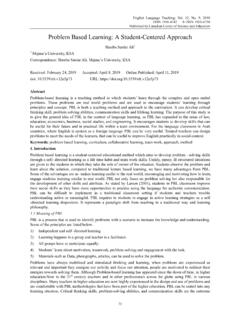Transcription of Health seeking behaviour-final - GOV.UK
1 University of Manchester Health Systems Development Programme A review of Health seeking behaviour: problems and prospects Author: Sara MacKian HSD/WP/05/03 The authors are members of the Health Systems Development Programme, which is funded by the UK Department of International Development. The UK Department of International Development (DFID) supports policies, programmes and projects to promote international development. DFID provides funds for this study as part of that objective but the views and options expressed are those of the author(s) alone. 2 Summary This review of Health seeking behaviour outlines the main approaches within the field, and summarises some of the key findings from recent work around the probes. However, it also suggests that Health seeking behaviour is a somewhat over-utilised and under-theorised tool.
2 Although it remains a valid tool for rapid appraisal of a particular issue at a particular time, it is of little use as it stands to explore the wider relationship between populations and Health systems development. If we wish to move the debate into new and more fruitful arenas, this review reaches the conclusion that we need to develop a tool for understanding how populations engage with Health systems, rather than using Health seeking behaviour as a tool for describing how individuals engage with services. This opens up into the broader arena of community organisation, social capital and citizenship; of political and non-political pressure points on the system. The paper suggests one way in which we might start to frame the debate in the context of this programme of work, using social capital and reflexive communities as key theoretical and analytical concepts.
3 31 Understanding Health seeking behaviour Health promotion programmes worldwide have long been premised on the idea that providing knowledge about causes of ill Health and choices available, will go a long way towards promoting a change in individual behaviour, towards more beneficial Health seeking behaviour. However, there is growing recognition, in both developed and developing countries, that providing education and knowledge at the individual level is not sufficient in itself to promote a change in behaviour. An abundance of descriptive studies on Health seeking behaviour, highlighting similar and unique factors, demonstrate the complexity of influences on an individual s behaviour at a given time and place. However, they focus almost exclusively on the individual as a purposive and decisive agent, and elsewhere there is a growing concern that factors promoting good Health seeking behaviours are not rooted solely in the individual, they also have a more dynamic, collective, interactive element.
4 Academics have therefore started to explore the way in which the local dynamics of communities have an influence over the well-being of the inhabitants. This reflects a growing interest across the social sciences in the contested concept of social capital. Attempts are now being made to develop this, as yet under-utilised idea, to incorporate knowledge about Health seeking behaviour into Health service delivery strategies in a way which is sensitive to the local dynamics of the community. This may be an extremely positive development. The whole area of knowledge around Health seeking behaviour is rendered of little value if not incorporated into management and system developments. The fact that Health seeking behaviour is not even mentioned in widely used medical textbooks (Steen and Mazonde, 1999), perhaps reflects that many Health seeking behaviour studies are presented in a manner which delivers no effective route forward.
5 This results in an unfortunate loss for medical practice and Health systems development programmes, as proper understanding of Health seeking behaviour could reduce delay to diagnosis, improve treatment compliance and improve Health promotion strategies in a variety of contexts. This paper draws mainly on evidence from our partner countries, to review the situation. It suggests what may usefully be learnt from studies to date, and begins to explore how we might make studies of Health seeking behaviour more useful from a Health systems development perspective. As part of this, it begins to explore some of the growing body of literature around local social development, participation and citizenship. This is usually divorced from the sort of one-on-one understanding of actual acts of Health seeking behaviour, but the paper highlights a few key studies that begin to make more explicit the importance of the links between the Health seeking behaviour of the individual and wider theoretical models of the local dynamics of Health systems and social participation.
6 In this review of the literature I work towards an understanding of how this more collective, situational, experiential understanding can be developed in a practical way through this research programme. Thus, it is suggested that although the debate is largely stagnant at present, it is possible to make progress by turning the old favourite of Health seeking behaviour into something more dynamic, useful and applicable in Health systems development. By the introduction of social capital, a potential way in which to develop the agenda around Health seeking behaviour is suggested. I begin by outlining the current picture, 4firstly drawing from the literature around Health seeking behaviour in general, and secondly by highlighting some key issues relevant to the probes. Health seeking behaviours: two approaches Researchers have long been interested in what facilitates the use of Health services, and what influences people to behave differently in relation to their Health .
7 There has been a plethora of studies addressing particular aspects of this debate, carried out in many different countries. For the sake of this paper they can simplistically be divided into two types, which roughly correspond with a division identified by Tipping and Segall (1995). Firstly there are studies which emphasise the end point (utilisation of the formal system, or Health care seeking behaviour); secondly, there are those which emphasise the process (illness response, or Health seeking behaviour). Health care seeking behaviours: utilisation of the system There is often a tendency for studies to focus specifically on the act of seeking Health care as defined officially in a particular context. Although data are also gathered on self care, visits to more traditional healers and unofficial medical channels, these are often seen largely as something which should be prevented, with the emphasis on encouraging people to opt first for the official channels (Ahmed, et al, 2001).
8 These studies demonstrate that the decision to engage with a particular medical channel is influenced by a variety of socio-economic variables, sex, age, the social status of women, the type of illness, access to services and perceived quality of the service (Tipping and Segall, 1995). In mapping out the factors behind such patterns, there are two broad trends. Firstly there are studies which categorise the types of barriers or determinants which lie between patients and services. In this approach, there are as many categorisations and variations in terminology as there are studies, but they tend to fall under the divisions of geographical, social, economic, cultural and organisational factors (see Table 1). Author Geographical Social Economic Cultural Organisational Kloos (1990) Geographical Socio-economic Cultural Yesudian (1988) Demographic Economic Cultural Organisational Leslie (1989) User factors Service factors Anderson (1995) Environmental Predisposing and enabling factors Health system Table 1: an illustration of categorisation of Health care seeking factors across studies These categorisations can be further broken down to illustrate the types of measures frequently used.
9 These are grouped under reoccurring determinants in Table 2, and placed into key spheres of influence: informal, infrastructure and formal. 5 Category Determinant Details Sphere Cultural Status of women Elements of patriarchy Social Age and sex Socioeconomic Household resources Education level Maternal occupation Marital status Economic status Cultural propriety informal Economic Costs of care Treatment Travel Time Type and severity of illness Geographical Distance and physical access Physical infrastructure Organisational Perceived quality Standard of drugs Standard of equipment Competence of staff Attitudes of staff Interpersonal process Technical Staffing Interpersonal formal Table 2.
10 Breaking down determinants of Health care seeking behaviour Secondly, there are studies that attempt to categorise the type of processes or pathways at work. Bedri (2001) develops a pathways to care model in her exploration of abnormal vaginal discharge in Sudan. She identifies five stages where decisions are made, and delay may be introduced, towards adoption of modern care . There are four sub pathways that women may follow, from seeking modern medical care immediately, to complete denial and ignoring of symptoms. This approach offers an opportunity to identify key junctions where there may be a delay in seeking competent care, and is therefore of potential practical relevance for policy development. For example, in order to optimise the pathways taken by women, Bedri suggests husbands should be involved in Health education programmes about vaginal discharge, and women should be enabled to conduct home vaginal swabs.
















